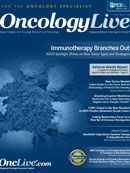Publication
Article
Oncology Live®
Research Leader Looks Beyond Genetic Mechanisms of Acquired Resistance to TKI Therapies
Author(s):
Settlemen addressed broad questions about his research into acquired resistance mechanisms in an interview with OncologyLive.
Jeff Settleman, PhD
Jeff Settleman, PhD, oversees efforts to identify and validate targets for oncology drug discovery and to discover predictive biomarkers for new cancer therapies. Prior to joining Genentech, Settleman spent 18 years on the faculty at Harvard Medical School as a professor of Medicine and director of the Center for Molecular Therapeutics at the Massachussets General Hospital Cancer Center.
Research in his laboratory is focused on understanding the mechanisms of acquired resistance to tyrosine kinase inhibitors (TKIs) in oncology. In 2012, his team reported on the role that receptor tyrosine kinase ligands play in conferring resistance to TKIs, such as hepatocyte growth factor in patients with melanoma treated with a BRAF inhibitor.1
Settlemen addressed broad questions about his research into acquired resistance mechanisms in an interview with OncologyLive.
What are your research interests as they relate to the development of resistance to targeted cancer therapy?
I’ve been interested in drug resistance in cancer for many years now. The problem has become increasingly appreciated with the development of many targeted agents, which generally fail after some time due to the development of acquired resistance. So, it’s obviously an important clinical problem. My research has been focused on the development of genetic mechanisms of resistance, for example the T790M EGFR mutation, as well as nongenetic mechanisms, which I think are becoming increasingly of interest but haven’t been as thoroughly investigated. Recently, my group has been particularly focused on understanding these nongenetic mechanisms.
One example of a nongenetic mechanism of acquired drug resistance is the so-called “epithelialmesenchymal transition,” also known as EMT.
This is a process wherein epithelial tumor cells assume a mesenchymal state, in which they tend to be more resistant to drug treatment. EMT is known to be driven by nongenetic mechanisms, and recent studies in EGFR-driven lung cancer have demonstrated the role of EMT in acquired resistance to EGFR inhibitory drugs.
Can you briefly describe our current understanding of how acquired resistance to targeted cancer therapies arises?
I think with pretty much all of the targeted drugs that are in development now or are approved for clinical use, there has been enough experience that we know that resistance develops in all cases and we also have data that point to specific resistance mechanisms. Those mechanisms have been determined in a couple of different ways. One way is simply analyzing patient tumor material before treatment and after progression on therapy and looking for differences that would explain mechanisms of resistance, mostly focusing on mutational mechanisms. Also, from preclinical studies modeling resistance in vitro, we’ve learned a lot about resistance mechanisms. I think those two approaches have provided a lot of insight into resistance mechanisms for pretty much every treatment that’s out there these days.
How is resistance detected?
We know resistance happens clinically, of course, when we see a patient who responds to a treatment initially and subsequently relapses on therapy. That would indicate clinical evidence of acquired resistance. We can analyze patient relapse tumor samples genomically and can potentially find evidence of some specific mutational event or over-expression of a certain gene that’s driving resistance. There have also been cases where it seems that differentiation of the tumor cells into a different cell type has contributed to the development of resistance. So there are a number of different mechanisms that have been detected just by studying the relapsed tumor.
There has also been a lot of interest in using circulating tumor cells and circulating plasma DNA to detect resistance mechanisms noninvasively. It can be challenging to rebiopsy a patient’s tumor outside of blood malignancies; other cancers are much more challenging to rebiopsy and it can be difficult for the patient, so unless there is a clear benefit, and it’s not simply for research purposes, it can be hard to justify doing it. So there has been a big push to use circulating tumor cells to identify resistance mechanisms noninvasively.
What are the most successful examples of methods that have been developed to overcome acquired resistance, in your opinion?
Well, I think for some of the targeted kinase inhibitors, like Gleevec in CML or for EGFR inhibitors like Tarceva and Iressa in NSCLC, we’ve seen good examples of second-generation kinase inhibitors that were specifically designed to overcome the resistance associated with the most common resistance-conferring mutations in the ABL gene in the case of CML and the EGFR gene in the case of lung cancer. Another example is the case of BRAF in melanoma, where it looks like using more than one pathway inhibitor may manage resistance more effectively than a single-agent treatment.
What are the most significant challenges to overcoming resistance?
I think there are a few things. One is that there can be multiple different resistance mechanisms arising in the same patient. Typically when we are treating patients with these targeted agents, they are often being treated in the advanced disease setting where there are multiple metastatic lesions in addition to a primary tumor and the development of resistance in those various lesions doesn’t have to be the same. So if you are dealing with multiple resistance mechanisms you may have to combine multiple treatments to effectively manage resistance and, of course, once you start combining therapies there quickly become some limitations.
So that’s one of the big challenges.
Then, of course, studying resistance mechanisms is challenged by the fact that it can be difficult to obtain serial biopsies from a relapsed patient and that’s really the only current tool we have for understanding what is clinically relevant in terms of resistance mechanisms. So, those are definitely among the key challenges.
Reference
- Wilson TR, Fridlyand J, Yan Y, et al. Widespread potential for growth-factor-driven resistance to anticancer kinase inhibitors. Nature. 2012;487(7408):505-509.










